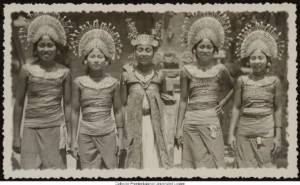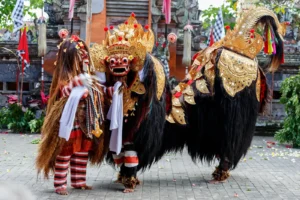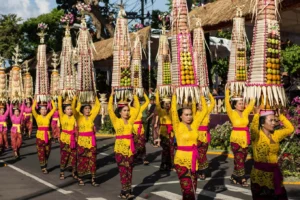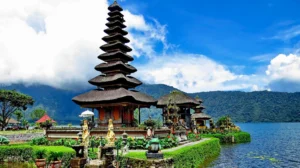Bali, the enchanting paradise that captivates the soul, opens its doors to explore the richness of its history, customs, culture, and dazzling natural beauty. As Indonesia’s most popular tourist destination, Bali not only offers the charm of its stunning beaches but also encompasses a historical heritage and deep traditions. The Bali map is the key to understanding the diversity and complexity of this island. There are many historical sites such as Besakih Temple, Ayun Garden, and Tanah Lot that can be explored through organized adventures using the detailed map of Bali.
In this article, we will guide you on a thorough journey to explore every enchanting aspect of Bali. Through the Bali map, we can plan travel itineraries visiting not only the main attractions but also traditional villages preserving the authenticity of Balinese culture. This map provides an overview of the island, from lush mountains to magnificent terraced rice fields. By understanding its topography and geographical distribution through the map, visitors can experience Bali’s natural wonders, including volcanoes, dense forests, and white sandy beaches.
In the exploration of Bali’s beauty, the map becomes an irreplaceable companion. Its use is not limited to navigation but also serves as a guide to discover unique places such as traditional markets, art galleries, and dance studios. The Bali map plays a crucial role in revealing the charm of the island, ensuring that every visitor’s experience encompasses the cultural depth and natural beauty of Bali. So, before embarking on your adventure, make sure to have an accurate and comprehensive map of Bali to enjoy everything this island has to offer.
Image of the Bali Map
source : pinterest.com
History of Bali: A Fascinating Timeline
source: balimediainfo.com
Tracing Bali’s history involves flipping through pages rich in past events. Before the Hindu-Buddhist era, Bali was inhabited by Papuan and Taiwanese peoples, bringing ethnic diversity. Then, in the 1st century AD, Hindu-Buddhist religion arrived in Bali, opening a new chapter in artistic and cultural richness. Historical remnants such as temples and ancient inscriptions tell the story of Bali’s glory and changes over the centuries.
In the historical map of Bali, we can explore temples such as Gunung Kawi and Lempuyang, visually transporting us through the past. This map becomes a virtual window providing access to historical sites, allowing us to feel the atmosphere as the Hindu-Buddhist civilization flourished on the island. Inscriptions like the Blanjong pillar in Sanur act as a guide, helping us understand the continuity of cultural values from generation to generation.
Bali not only preserves its history but also celebrates it through festivals like Galungan and Kuningan, strengthening spiritual and cultural ties. The Bali map becomes the ultimate guide for history enthusiasts who want to understand the context and significance of these cultural events. Using the map, visitors can plan their trip to participate in these festivals, creating a deep experience in the daily life of Balinese society.
By participating in these traditional celebrations, tourists not only observe but also feel the warmth and joy that extend into the ancient history of this island. As a tool that opens the door to various historical and cultural events, the Bali map is not only a practical guide but also a window into the richness and beauty that envelop this island.
Balancing Tradition and Modernity
source: hotels.cn
Bali has the unique ability to maintain a balance between tradition and modernity. While Balinese customs remain strong and respected, the island does not shy away from embracing contemporary developments. Ngaben ceremonies, which convey the Balinese-Hindu philosophy of life and death, are still celebrated with fervor, while international nightclubs and luxury resorts welcome visitors with modern comfort. This creates a unique atmosphere where the past and present harmoniously converge.
In cities like Ubud, the artistic and cultural center of Bali, one can witness traditional dance performances that remain vibrant. Dance performances such as Legong and Barong are not just entertainment but also showcase the community’s commitment to preserving inherited arts. These efforts act as a kind of cultural map guiding visitors to the rich and deep roots of Balinese culture. Furthermore, modern art and works by contemporary artists decorate galleries in Seminyak and Canggu, expressing the fusion of past and present.
Cultural and artistic maps like these help portray the beauty and complexity of Bali that attracts the attention of tourists worldwide. They can plan their trip using a map that encompasses not only historical sites but also contemporary points of interest that captivate modern art enthusiasts. Thus, the island preserves its cultural roots while continuing to progress into modernity, creating a uniquely captivating experience for every visitor exploring the beauty of Bali.
Balinese Culture: Infinite Art
source: thehinduportal.com
Art in Bali goes beyond mere expression; it is the living soul of the island. On a daily basis, Bali is adorned with fascinating art that awakens the senses, creating a deep cultural experience for its visitors. The Bali map becomes even more captivating when we explore the artistic richness present at every corner of the island, connecting and describing the beauty of its priceless artistic heritage.
Wayang kulit, with its delicate shadows, plays a crucial role in narrating the epics of Ramayana and Mahabharata. Every movement and shadow creates a magical show, emitting a distinctive narrative power of Bali. The gamelan, a traditional musical ensemble, dances in the air with enchanting melodies, offering a captivating auditory experience in every town and village.
Ubud, with its artistic sculptures and paintings, becomes a dazzling visual center. Each brushstroke or sculpture has a story and deep meaning, reflecting the legendary elegance and gentleness of Bali. On the Bali map, the village of Celuk is known for its silver crafts, while Tohpati is where traditional batik thrives rapidly.
Natural Beauty: Paradise Under the Sun
source: gambiacastle.net
The Bali map, a guide to exploring the beauty of nature, directs the journey through the charms of the island. Iconic beaches such as Kuta, Seminyak, and Nusa Dua are clearly marked on this map, offering the allure of white sand, tempting waves for surfers, and refreshing sunsets.
The Bali map is the key to discovering the natural facet of the Island of Gods, indulging nature lovers with green mountains like Mount Agung and Mount Batur. The terraced landscape of Tegallalang and Jatiluwih, highlighted on Bali’s nature map, invites strolls among lush rice fields and captivating views that mesmerize visitors.
Waterfalls also play a romantic role on Bali’s nature map, with Sekumpul waterfalls in Buleleng and the magnificent Gitgit waterfall. Both waterfalls are clearly marked on the map, offering views of dense forests and mesmerizing clear water. Not only that, but the Bali map provides information on trekking routes and mountain biking trails, guiding adventure through green expanses and dramatic panoramas that enchant visitors.
Explore the Wonders of the Island with the Bali Map
The Bali map is an invaluable treasure, guiding us through more than lines and symbols. The key to the wonders of this island lies in its indications that lead to historical sites, sacred temples, and spiritual journeys to holy places. With this map, a comprehensive exploration of the island becomes possible, revealing the cultural charm and spiritual beauty that adorn Bali.
By using the Bali map, we are not only planning physical itineraries but also feeling the touch of history and spirituality through its indications. In this journey, each indication on the map brings an experience awakening the sanctity of temples and leads to a deep understanding of Bali’s cultural heritage.
Not to forget, the Bali map becomes a guide to savoring unique traditional events, such as the Melasti ceremony on Bali’s beaches. With the Bali map, we can highlight the importance of these indications as a window to the cultural, historical, and spiritual wealth that enriches every step on the Island of Gods.
10 Tips for a Bali Vacation Using the Bali Map:
Bali, with its captivating natural charm, is an appealing vacation destination for many travelers. To maximize your holiday experience on this island, using the Bali map is a smart move. Here is a more detailed expansion on 10 tips for a Bali vacation using the map:
-
Plan your travel itinerary: When planning your itinerary, pay particular attention to the uniqueness of each region of Bali. The map will help you identify interesting places and plan your trip according to your personal preferences. Make sure to establish a schedule to explore the most important places.
-
Understand Bali’s geography: Understanding Bali’s geography will help you avoid delays and confusion during your trip. Make sure to mark areas that might be challenging to find on the map, such as small streets or important points that will facilitate your navigation.
-
Explore major tourist sites: When visiting major tourist sites such as Tanah Lot or Ubud, use the map to ensure you visit the desired destinations. With the map as a guide, you can maximize your vacation time and manage your trip without confusion.
-
Choose strategic accommodation: Choose strategic accommodation using the map. Consider a location close to major destinations or public facilities, allowing you to save travel time and enjoy your vacation more.
-
Look for alternative routes: Alternative routes can add a unique touch to your trip. By understanding the Bali map, you can find less-traveled paths, leading you to places rarely visited by tourists and adding an adventurous touch to your vacation.
-
Use navigation apps: Use navigation apps or a GPS to ensure you don’t get lost and reach your destinations efficiently. This will also help you avoid traffic jams that may occur in densely populated areas.
-
Don’t forget the small islands: Bali has several small islands around it. Check the map to see if there are neighboring islands worth visiting.
-
Learn the local culture: Use the map to mark the locations of traditional sites, temples (pura), and traditional villages. This gives you the opportunity to experience Bali’s cultural diversity.
-
Prepare with support facilities: Mark the locations of ATMs, gas stations, and tourist information centers on the map. This can help you in emergencies or urgent needs.
-
Explore local cuisine: Don’t forget to mark places where renowned local dishes can be found on the map. Bali has a culinary wealth worth discovering.
With careful planning and using the map, your vacation in Bali will be an unforgettable experience. Make sure to always update your map and enjoy your adventure on the Island of Gods!
Conclusion
Bali, far from being just an ordinary vacation destination, is a magical journey that transports us through time, absorbs the wisdom of ancestors, and celebrates life in all its extraordinary beauty. The Bali map is the key to understanding the essence and uniqueness of this island, faithfully guiding us through each of its captivating corners. From enchanting beaches to majestic mountain peaks, every piece of land in Bali becomes a stage for stories waiting to be revealed.
Open your map and let each symbol and line take you on this amazing adventure. The Bali map is a faithful companion that helps reveal the charm and wisdom inherent in its culture and nature. Bali awaits to captivate your senses, envelop you in its welcoming cultural warmth, and fascinate you with its unparalleled natural wonders. By using the Bali map, every journey of bali with Salut Bali becomes deeper, more meaningful, and full of significance, opening the door to the hidden beauty of this paradise island.









